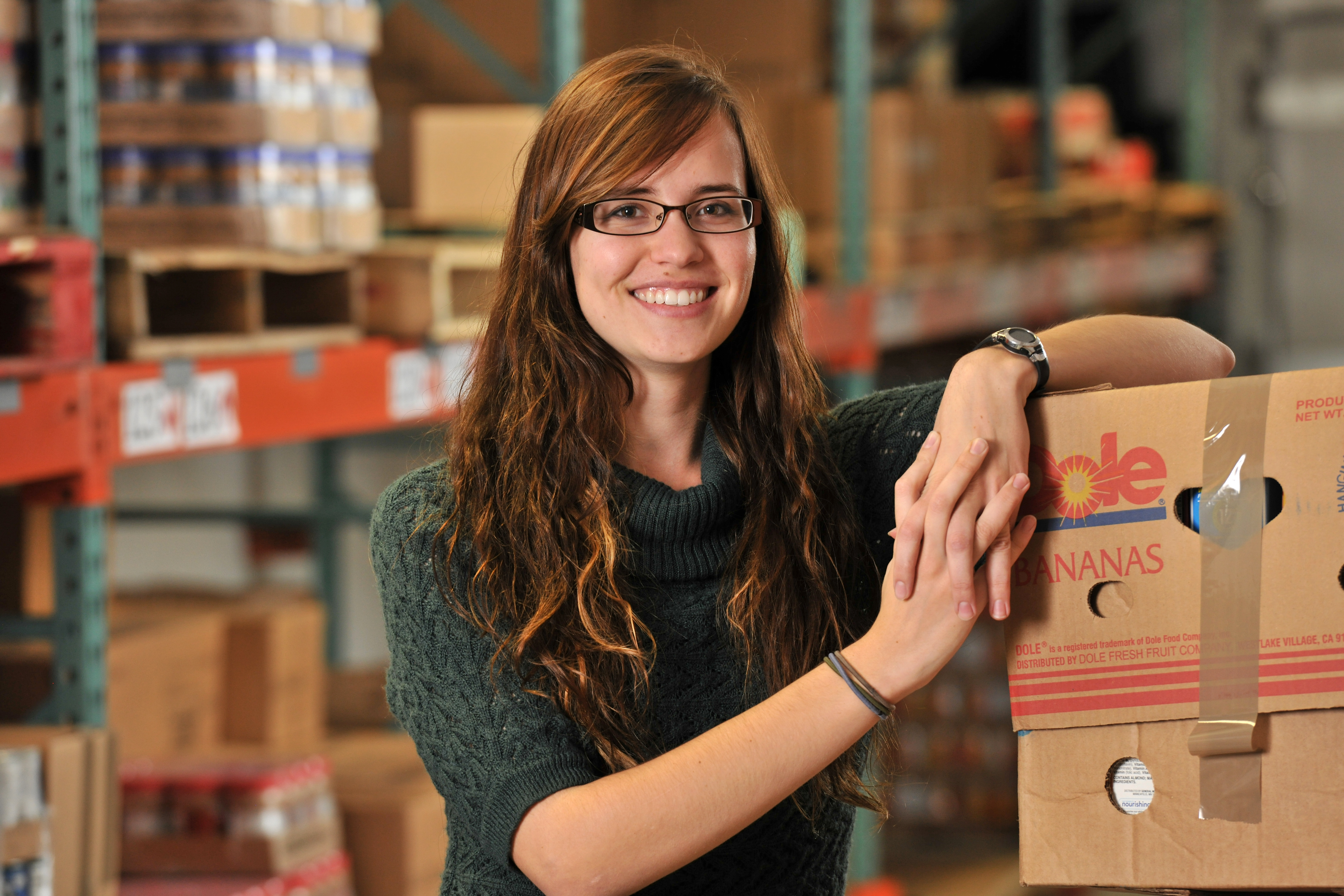by Jenni Hodges
Des Moines Area Religious Council (DMARC) food pantries have supplied groceries to nearly 14,000 families this year, but network director Rebecca Whitlow says the Council’s 12 existing pantries are not enough. Whitlow said she knows there are pockets of need these pantries are not meeting.

Rachel Frana ’15 is using GIS mapping technology to help food pantry network director Rebecca Whitlow, left, and DMARC executive director Sarai Rice, right, identify underserved areas of Des Moines.
That’s why DMARC has enlisted Rachel Frana, a Central College student from Ridgeway, Iowa, to help identify underserved areas. Frana, a senior environmental studies major, is using Geographic Information Systems (GIS) to map the locations and demographic data of over 8,000 families served by DMARC pantries. Executive director Sarai Rice said this information will help guide the Council’s next steps.
One likely step, Rice said, will be to open a new pantry in an underserved area. In this event, Frana’s maps will help determine the best location. “People in need of food also often lack transportation,” Whitlow said, “so we try to put pantries where they are needed.”
Frana will also connect clients’ locations to their demographic data, showing which pantries serve — or ought to serve — large numbers of distinct age or ethnic groups. This will help DMARC customize its pantries to the needs of different areas, Whitlow said. For example, some refugee clients might prefer rice to unfamiliar items like spaghetti sauce and canned fruit.
“Anything we can know about our clients helps us serve them better.”
– Sarai Rice, executive director, Des Moines Area Religious Council
Besides investigating these questions, Frana said her maps may reveal other, unforeseen connections among food pantry clients. A map, Frana said, will make this information easy to understand quickly — even for people with no knowledge of GIS.
Although no DMARC staff members are trained to use GIS, Frana said her work will be available to them for other projects. “I want to take it a step further,” Frana said. “I want to lay a foundation they can work off in the future.”
Frana’s project files will be a resource for anyone who partners with DMARC for GIS research. “We know so little about this,” Rice said. “Part of what we’re trying to learn is what knowledge we could ask for in the future.”
For the moment, Rice said Frana’s project comes at a perfect time. DMARC is currently considering a new business model for a mobile food pantry, and Frana’s work will provide research to help guide the Council’s decision.
“There’s something satisfying to me about creating a map no one’s ever made before.” – Rachel Frana ’15
According to Rice, the proposed food truck would offer fresh fruit and vegetables in Des Moines’ food deserts. The mobile pantry would sell items slightly above wholesale price, Rice said, providing a shopping opportunity in regions without grocery stores. Besides making fresh produce available, Rice said she hopes this affordable option could support clients’ dignity, since many find it difficult to accept free groceries — even in cases of desperate need.
DMARC received help for a similar mapping project during the 2008 recession. However, Whitlow said the pantries now serve twice as many clients as they did then. “Even though the economy is getting better, it’s not getting better for the clients we serve,” Whitlow said. “They’re still struggling.”
With such a large number of clients, Rice said Frana’s research will help DMARC learn information they can’t hear from each individual personally. “Anything we can know about our clients helps us serve them better,” Rice said.
Meanwhile, Frana said she is grateful for more experience in GIS, a growing field in which she hopes to work after graduating from Central College. “They’re telling me their needs, and I’m figuring out what to do,” Frana said. “There’s something satisfying to me about creating a map no one’s ever made before.”
What is GIS?
Geographic Information Systems (GIS) is used to map spatial data and connect it to other information. This technology is used to visualize information (like GPS maps or election results), and it can help direct business strategies, track the spread of disease and plan efficient transportation.
GIS at Central College
Central is one of few schools that require GIS instruction and experience for all environmental science majors. Frana was introduced to GIS in a course with Anya Butt, associate professor of biology. Frana said learning GIS is difficult, but she finds it interesting because the technology is useful in so many real-life applications. Butt also created an advanced GIS course for Frana and four other interested students at Central.
This fall, Frana and Jordan Strumpfer ’15 are using GIS technology to map Central’s campus. Frana and Strumpfer, both environmental studies majors, won a $2,000 grant for GPS equipment for this project.


